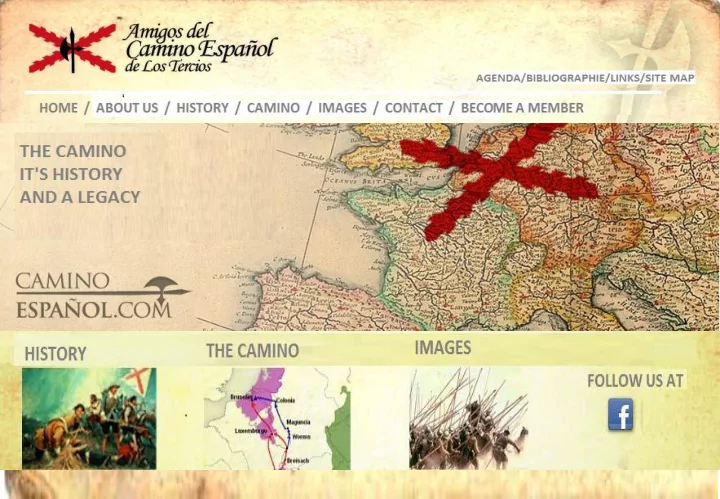

• We are an association whose aim is to preserve the memory of the Camino Español and the feats of arms of the soldiers who travelled the Camino to fight for Spain’s cause. We strive to encourage the study and promotion of any and all aspects related to this logistical achievement, which has no equal in Europe, by means of trips, conferences, publications and the collaboration of institutions and organizations who are interested in shedding light on a glorious episode in our History which should never be forgotten. • We would like to recover the memory of the Tercios and we offer our services as a forum to bring together those who also share this aim. We work to encourage and promote the knowledge of the deeds of these soldiers through conferences, seminars, debates, publications and trips. The Camino Español , an itinerary filled with natural beauty and an extraordinary cultural and historical patrimony, begins in Milan and moves through the European countryside all the way to Namur. In modern times the Camino is well connected and just as easy to follow as other itineraries of great historical foundation. In fact, the Camino follows the backbone of modern Europe. Our members include experts in the knowledge of the Camino Español and its main sites in Flanders, where we have already made various expeditions based on our experience, knowledge and capacity to organize educational trips with no other purpose than to promote this brilliant page in our history. • Statutes of the Association registered under number 597543 on May 10, 2011 at the National Registrar of Associations of the Interior Ministry.
• The Spaniards I want on the sea…If on land we find them, Saint George protect us. • Thus reads an English proverb from centuries past to describe the good work of the Spanish Infantry and the great talent shown by those Spanish infantrymen while handling their weapons, demonstrating a skill and bravery unlike that of any other kind of soldier. • The Tercios were much feared and respected by the many adversaries young Spain had. It was the emperor Charles V, King of Spain and Emperor of the Holy Roman and German Empire who created the Tercios . • These men were hardened by battle and the kind of life they lived. They were more disciplined than any other soldiers on the battlefield. They were skilled with the sword, enormously brave and they had a great sense of honor. The Tercios have led the Spanish Infantry through hostile and far-off lands, earning fear and respect. Even at sea the Spanish infantrymen were feared when they used the sword and harquebus. • But it was in Flemish lands, in Flanders, where our Tercios sustained with blood and fire the lands that the Habsburg dynasty refused to give over to Protestant hands.
The Camino Español was first described in 1563 by Cardinal Granvela: When Philip II was thinking of visiting the Netherlands, the cardinal told him that the safest and most comfortable route was to leave from Spain via Genoa, which would take them to Lombardy. From there they would pass through Savoy, Free County of Burgundy and Lorraine. This itinerary had one clear advantage: it was a journey almost entirely through their territories. The King of Spain was also the Duke of Milan and he governed the Free County of Burgundy as the Sovereign Prince. During the period of the Habsburg dynasty, Spain patiently formed close alliances with the governors of the territories which separated its dominions. Since 1528 Spain had been the main supporter of the patrician who governed in Genoa. The Duke of Savoy was an old ally, based on the legal foundation of the Groenendaal Treaty (March 26, 1559), but the truly lasting “entente” between the States was rooted in Savoy’s desire to obtain French territory (for which it needed Spain’s help), and Spain’s need for a military corridor between Milan and the Free County of Burgundy. The Duchy of Lorraine lived a situation of neutrality which had been agreed upon between France and Spain in 1547. These conditions allowed the legal passage of all kinds of troops as long as they did not spend more than two nights in the same place. After passing through Lorraine, the troops travelling from Italy to the Netherlands went through Spanish Luxemburg. While Spain had a strong friendship with the States which housed the milestones along its route to the Netherlands, these States were completely independent and every time the troops travelled through them, they would send forth respectful diplomatic propositions.
Fill out your personal information and send us an email with your questions or queries. We will respond shortly.
• Download the on-line registration form, fill it out and send it to info@elcaminoespanol.com. You can also send it by post to PO Box nº 494 in Toledo, Spain.
Recommend
More recommend